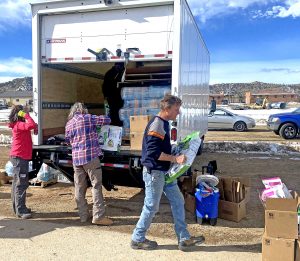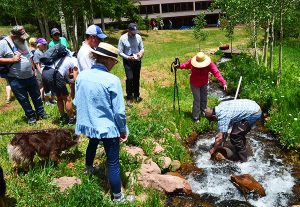by Nancy Christofferson
HUERFANO, LAS ANIMAS — The earliest surviving newspapers published in Huerfano County were issues of the Huerfano Herald, printed from late 1880 to 1883. Its pages, written and published by J.B. King, illustrate a life far different from ours today, but then, that was 135 years ago.
Agriculture was king in those days. As the year opened, Trinidad newspapers, the Advertiser and the Times, were freely quoted by Editor King with the latest news. One item stated the cattlemen “prophesy” cattle would not bring as much as $20 a head by the end of 1884. This must have caused much dismay because there were upwards of a half million head were roaming the ranges of southeastern Colorado.
In fact, of Las Animas’s 12 established post offices that year (not including those now in Baca County, which was parceled out of Las Animas in 1889), 10 were rural and serving the farmers and ranchers of their areas. Just two were in coal or coke camps, Starkville and El Moro, and one was the budding metropolis and county seat of Trinidad.
A range cattle sale in February 1883 brought $24 per head. Meadow hay sold for about $15 a ton while timothy sold for $22.
While hay could be grown anywhere with a good water source, the upper Purgatory Valley was strictly for grazing and potato raising. In 1881 farmers had shipped out 229,749 pounds of potatoes from the Stonewall area. At the time, potatoes were bringing $1.25 to $1.50 per 100 pounds, wholesale. 1882 had been a very good year for crops, too good, perhaps. The next February, surplus grains were still on the market.
It was of interest to every reader of the Las Animas and Huerfano counties’ four newspapers of the time that the January low temperature of minus 18, measured during a blizzard, had not affected the cattle to any degree. The sheep fared well enough, but the heavy snowstorm on June 8 killed thousands in the foothill and mountain pastures, since it followed lambing and shearing.
This was the time of the Hereford. Opinions differ on just who brought in the first registered animals, but it seems to have been in the La Veta area, which sixty years later was touted as the “birthplace of the Hereford industry”. Whatever breed Hamilton Pope was raising at his place not far south of the Pueblo County line, they were big. Pope butchered a steer in January that yielded (he said) 1,090 pounds of meat.
Joseph Bourcey believed in a different kind of agriculture. A native of France, Bourcey raised grapes and made his own wine at his farm home in Walsenburg. He evidently shared some of the product with the local editor because he scored some free advertising (and deep appreciation).
While rural residents outnumbered those living in towns, not everyone was invested in crop or livestock raising. Precious metals were much on folks’ minds, and areas not tread upon before, or much since, were home to prospectors from the most humble to the mighty, such as Iowa Senator James Harlan, who owned several mines on the north slopes of the West Spanish Peak (one of his partners was Secretary of War Robert Todd Lincoln). Harlan actually put two shifts to work at his Mountain Monarch (later known as the Bullseye). He couldn’t spend his money fast enough having tunnels dug willy-nilly by local men, who no doubt filed on their own claims nearby while cheerfully collecting their paychecks. These laborers could earn a dollar a day, and the daily cost of living was 80 cents.
The copper mines on Pass Creek were especially flourishing, with hundreds of miners pouring in with the rumor of a new stamp mill and available employment. In anticipation of a “boom”, the merchants of Gardner and Malachite increased their stocks of goods. Saloonkeepers were also preparing.
On the south side of the peaks in Trujillo Canon, strikes of gold, silver and copper, along with lead, were keeping miners hopping. Some ore from one mine assayed at $400 in silver per ton. Soon after one mine sold for $8,000, a town was located nearby, and it may have been those same “prophesy” fellows who forecast a population there of 1,000 within six months.
The valleys and peaks of Huerfano County were equally busy. One spot where gold was found was especially popular, particularly with miners from the Rosita and Silver Cliff area, was north of Gardner and dubbed Birmingham. A tent city had popped up in the fall of 1882 and soon more than 500 hopeful souls were living there. One silver mine near there sold for $1,000 in January 1883, and a post office named Houck opened in February. Within six months the entire townsite had been abandoned and the post office discontinued.
Huerfano had 16 post offices in 1883, and Birmingham and Houck were the only mining towns. What was called the Walsenburg Coal Banks, or Walsen’s, had producing mines and a growing population but no official recognition as a town.
The other 14 post offices were in farming and ranching communities, including the municipalities of Walsenburg and La Veta.
With all the grain crops being harvested, the local mills were operating steadily. These included the La Veta Roller Mills and the Malachite Flour Mills. Popular crops of the day were wheat, corn, barley and rye.
Colorado was so reliant on its livestock and crops that it levied a bounty on noxious weeds that could hamper production. It would pay, for instance, a cent and a half for each pound of loco weed collected, so the residents of Las Animas County got busy and tore out 100,000 pounds of it.
While the food producers were prospering, the largest taxpayer of Huerfano County remained the Denver and Rio Grande Railroad. With its various branches and constant extensions, the company was employing no fewer than 1,200 men to operate and repair the line. Owing taxes of $10,977.75, the D&RG outdistanced the most successful merchants, Walsen and Levy of Walsenburg, and the richest livestock raiser, Benton Canon, by two and half times. It was in 1883 that the D&RG completed a line into Salt Lake City so a traveler could reach all the way west to San Francisco. After seven years of supporting “eating stations” on each side of La Veta Pass, the D&RG actually was planning to build its own restaurant at the summit.
So, with all the activity, 1883 was a profitable year. This brought on a series of radical new ideas, like tax levies.
In August, the Walsenburg town board heard about the evaluation being set at $80,000, so wasted no time in levying a three mill tax to beautify the town. This probably meant the purchase, planting and maintenance of trees, but may have included some new board sidewalks.
La Veta, where the property value was set at $58,872, the board passed a six mill levy to raise $350 for town purposes. About the same time, School District No. 9, La Veta, approved another six mill levy to raise enough to pay its teachers (both of them) to work a full nine months (instead of four or five, depending on finances), and to establish a contingency fund.
As soon as the town admitted its worth, and its levy to raise $350, Henry Daigre offered to sell his land north of town, which the town was contemplating condemning for a public road, for $335. Easy come, easy go.
The Trinidad school board announced that henceforth, no language but English could be taught in the public schools. The La Veta editor speculated this “should result in lively controversy”.
The possession of real money (though residents were being warned to watch for counterfeit half dollars) may have enticed the Old John Robinson’s 10 Big Gigantic New Shows Combined for 1883 to visit La Veta. It was the first circus ever to appear in Huerfano County, and some 1,500 attended, which happened to be the estimated population of the entire county in 1880. The troupe included 150 acts, sideshows and attractions under tents, which required the entire railroad property from the river east to the road, north of the depot.
That was 135 years ago, and La Veta is still waiting for its second circus.





